This exhibit is organized by the Museum Center for Persecuted Arts, and is part of The Holocaust and the United Nations Outreach Programme‘s commemoration of the November Pogrom (9-10 November 1938).
Exhibition by
- Museum Center for Persecuted Arts, Solingen
- Yad Vashem, Jerusalem
In cooperation with
- MOCAK Museum for Contemporary Arts Krakow
- Boris Lurie Art Foundation
Curators
- Eliad Moreh-Rosenberg
- Jürgen Joseph Kaumkötter
Design
- Timon Wißfeld – Gutes im Falschen
Photographs by
- Jörg von Bruchhausen
- CICS – Cologne Institute of Conservation Sciences
- Museum am Dom, Dioceses of Würzburg, Art Collection Foundation
Interview with Yehuda Bacon by
- Julia Riedhammer
- Christine Thalmann (rbb. Rundfunk Berlin-Brandenburg)
Supported by the Foreign Office of the Federal Republic of Germany and the Permanent Mission of Germany to the United Nations. Museum Center for Persecuted Arts is part of the Cultural Heritage Network of the Landschaftsverband Rheinland
Yad Vashem
Spanning some 45 acres across Jerusalem’s Mount of Remembrance, Yad Vashem is the world center for Holocaust education, remembrance, research and documentation. For seven decades, Yad Vashem has dedicated itself to perpetuating the memory of the Jewish men, women and children who were murdered by Nazi Germany and its collaborators, and to passing on the legacy of the survivors. Its state-of-the-art museums, world-class research and education centers, and expansive archives and libraries provide an unparalleled venue for inter-generational learning and contemplation, reflected also in its comprehensive online resources utilized by millions of people around the globe.
Drawing on the memories of the past, Yad Vashem seeks to meaningfully impart the legacy of the Shoah for generations to come. Yad Vashem’s Art Collection comprises close to 14,000 works of art, half of which were created during the Holocaust. These provide a unique perspective based on the individual’s experience. Each of these works is, in essence, an irreplaceable personal testimony of human existence during the Holocaust.
Museum Center for Persecuted Arts
The Museum Center for Persecuted Arts is devoted exclusively to the persecuted arts of the twentieth century up to the present day. Its collection and exhibitions focus on works from the fields of the visual arts, literature, music and theater, particularly those created by individuals persecuted by the Nazi regime. Through its multidisciplinary exhibitions, the Center for Persecuted Arts fills a gap in the museum landscape by drawing attention to the diverse expressions of overt resistance or defiance by artists and writers in authoritarian regimes, thus addressing an important self-empowerment independent of the art canon and the art market. Through artistic articulations, the museum demonstrates how the existential and life-threatening experiences of flight, expulsion, persecution and exile can be described and overcome, then and now. The museum’s inaugural exhibition, Der Tod hat nicht das letzte Wort (Death Does Not Have the Last Word) in the Bundestag in Berlin in 2015 programmatically demonstrated the museum’s orientation: emphasis on the continued importance of remembrance and survivors’ commitment to the representation and analysis of the Holocaust.
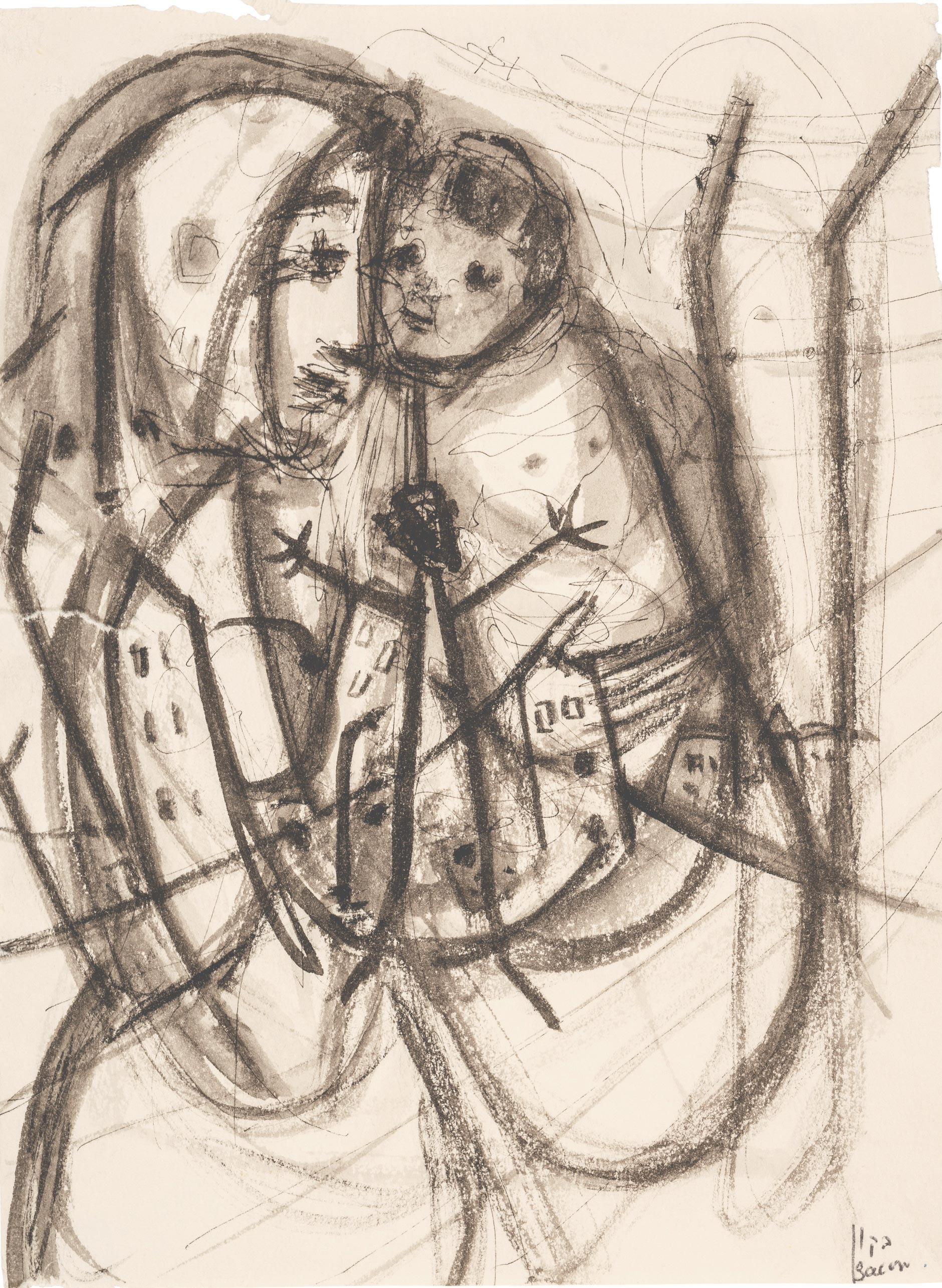
Yehuda Bacon, Woman with child at the barbed wire fence of a concentration camp
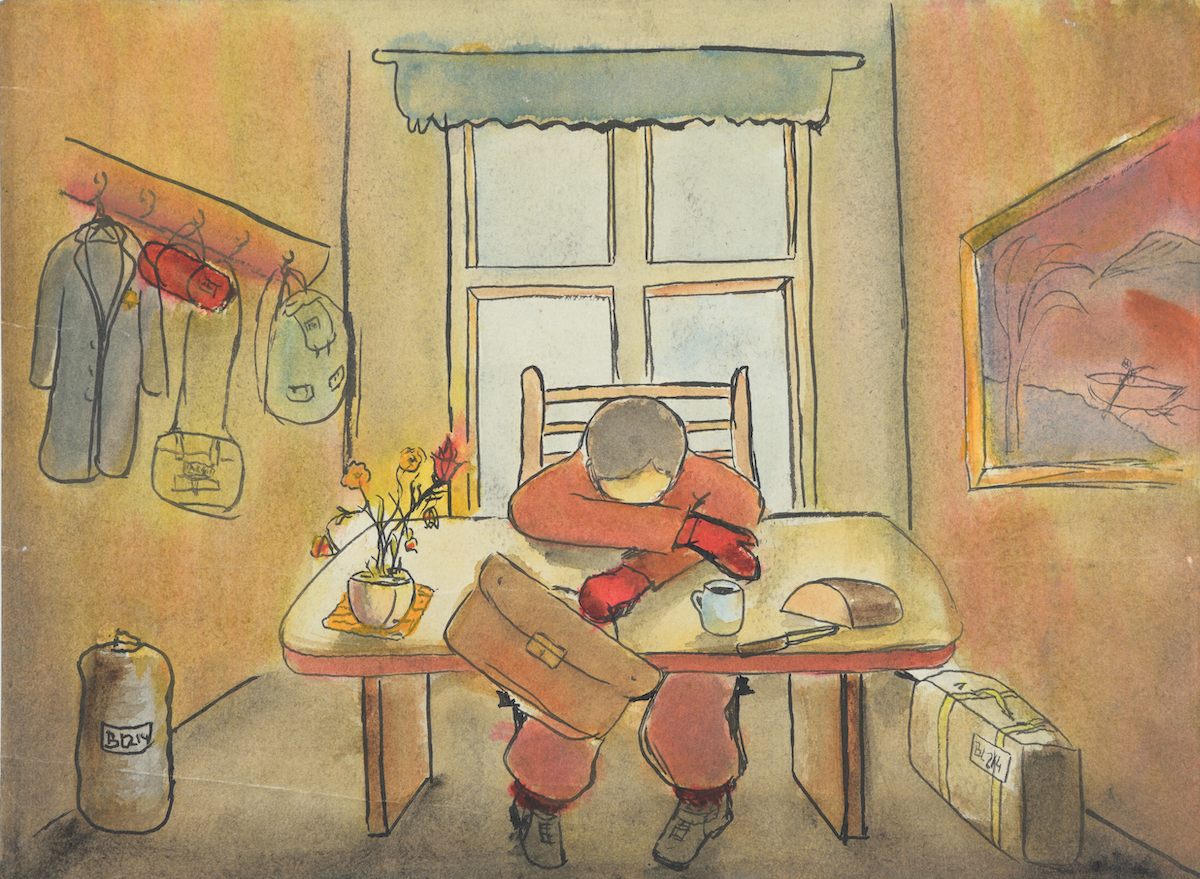
Yehuda Bacon, Before the Transport to Terezín, 1945
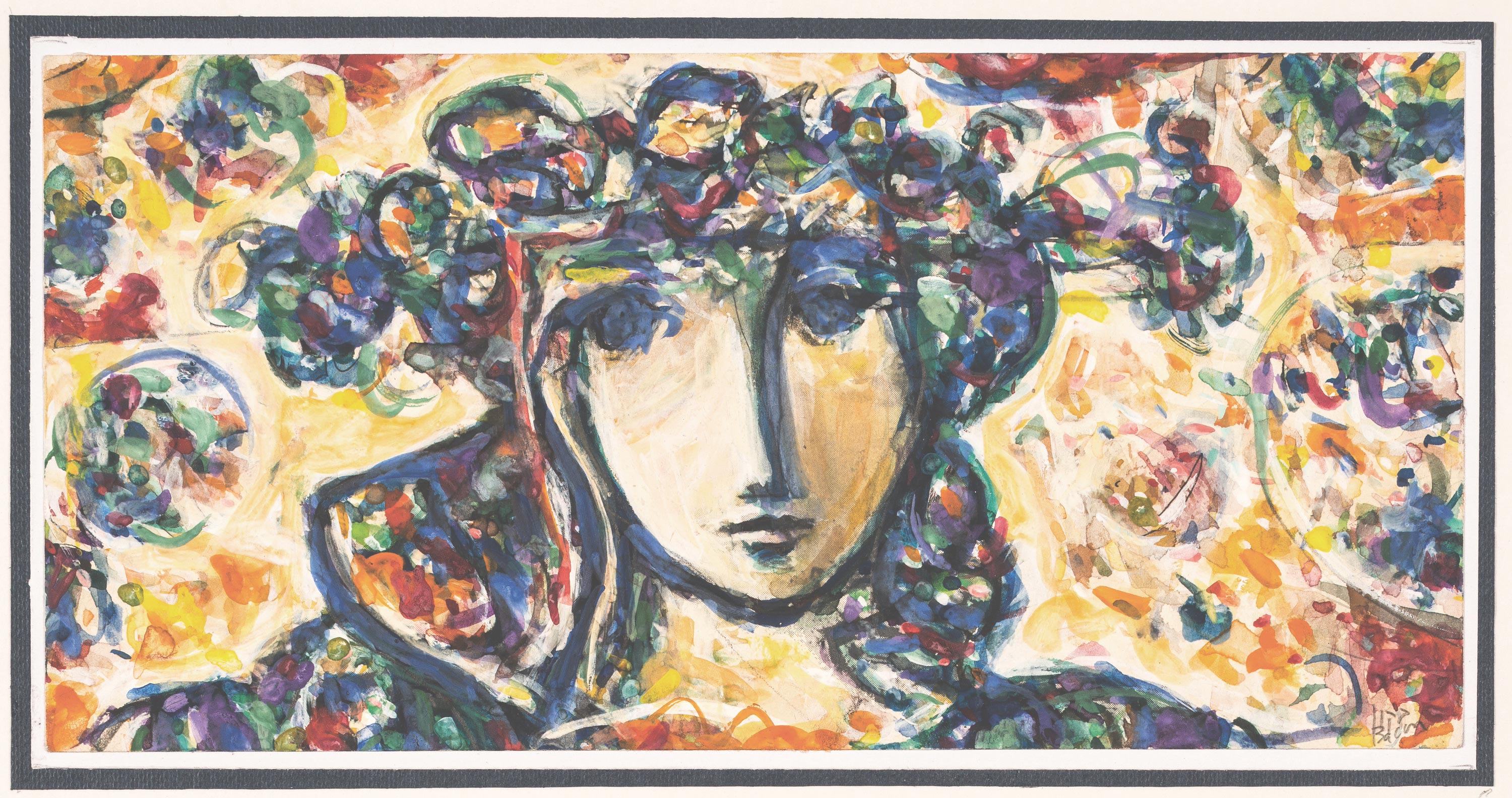
Yehuda Bacon
This exhibition highlights the importance of art for Holocaust remembrance today. It presents three generations of artists whose lives were impacted by the Holocaust, and whose art was shaped by this experience.
Organized chronologically in seven sections, the exhibition revolves around artist and witness Yehuda Bacon (b. 1929). The display begins with German Jewish artists such as Ludwig Meidner and Felix Nussbaum, who responded to the November Pogrom of 1938 in their painting, foreseeing the destruction of European Jewry, and continues with artworks from the Terezín ghetto. Included are Karel Fleischmann (1897–1944), who gave Yehuda Bacon his first drawing lessons in the ghetto, and painter, poet and art teacher Peter Kien (1919–1944). Other prisoners such as Friedl Dicker-Brandeis also taught the boys and girls in Terezín. The work of Boris Lurie (1924-2008) is displayed as are works created after 1945 by other artists, who like Bacon, were the only survivors of their families.
The main section focuses on Yehuda Bacon, from the drawings created immediately after his liberation recording his experiences in Auschwitz Birkenau German Nazi Concentration and Death Camp (1940-1945), to the paintings reflecting his own mature style. In addition to his artistic career, Bacon kept his oath to testify to the world about the crimes of the Holocaust and served as a witness at the Eichmann trial in Jerusalem in 1961 and at the Auschwitz trials in Frankfurt am Main in 1964.
In parallel, Bacon taught art for 35 years at the Bezalel art academy, initiating a generation of young artists into the secrets of draftsmanship and printing techniques. Sigalit Landau was one of these young artists. The exhibition thus ends with this internationally-acclaimed Israeli artist, daughter of a Holocaust survivor, who refers to the Holocaust with a personal, yet universal approach. Ultimately, the artistic thread connecting teachers to their students echoes the transmission of memory from the Holocaust victims and survivors to the following generations, emphasizing the power of visual testimony in the commitment to Holocaust remembrance and our responsibility to educate about its relevance.
This exhibition forms part of the 2023 programme of Holocaust remembrance and education organized by The Holocaust and the United Nations Outreach Programme. Member States of the United Nations established The Holocaust and the UN Outreach Programme (General Assembly resolution 60/7). The Outreach Programme is an expression of the commitment of the UN to fighting hatred, and to contribute to building a world in which all can live in peace and with dignity.
The Holocaust (Shoah)
The Holocaust (Shoah) was the anti-Jewish campaign initiated and implemented by Nazi Germany during the years 1933-1945. Its culmination was an unprecedented and systematic genocide that aimed to totally eradicate Judaism and annihilate the Jewish people.
The campaign’s primary motivation was an antisemitic, racist ideology, which asserted that the Jews were a danger to Germany and to humankind as a whole. According to this ideology, the Jews were parasites who exploited non-Jewish peoples and disseminated ideas about human equality perceived as undermining the natural and ostensibly appropriate hierarchy between the so-called “races”.
From 1933 onwards, Nazi Germany implemented anti-Jewish policies: initially, they defined who were Jews, stripped them of most of their rights, their professional status and their property, and acted to isolate them socially. During the Second World War, anti-Jewish measures escalated, both in Germany and in occupied and Germany-allied Europe, and included banishment from the general population by marking, segregating or concentrating Jewish people in ghettos, forced labour, starvation and more. These actions gained support in Germany and other countries, and led to the Jews’ removal from civil, social and economic life in their countries of residence.
The systematic murder of Jews began in the summer of 1941 with the invasion of the Soviet Union, and Nazi policy gradually developed into a comprehensive genocide termed “The Final Solution to the Jewish Question”. By the end of the war, nearly six million Jews had been murdered.
In addition to the policy to annihilate all Jews, the Nazis targeted others. Germans with disabilities were the first victims of organized murder; several million Soviet POWs (Prisoners of War) died through brutal treatment or were murdered; homosexual men and political dissenters were frequently interned in camps, where many died; the Poles were oppressed by their German occupiers and in particular Polish elites were imprisoned in camps or murdered outright; many Germans of African descent were subjected to sterilization; and the Sinti and Roma were subjected to genocide.
Felix Nussbaum
The November Pogrom 1938
Born in Osnabrück in 1904, Felix Nussbaum studied art in Hamburg in 1922 and a year later continued his studies at the Lewin-Funcke School in Berlin, where he enrolled in the class of Ludwig Meidner. Following the Nazis‘ rise to power, he wandered through Europe and in 1935 sought refuge in Belgium for himself and his partner, the artist Felka Platek. Initially, the couple lived in Ostend; two years later, they moved to Brussels. Following the German occupation of Belgium in May 1940, Nussbaum was arrested and interned in the Saint-Cyprien camp in southern France. Several months later, he escaped and returned to Brussels, where he went into hiding with his wife. He created dozens of artworks reflecting the anguish of the persecuted Jews. Only with the help of friends, who secretly safeguarded the works, did these survive the war. In June 1944 the couple was denounced, arrested and transferred to the Mechelen camp. In July they were deported on the last transport from Belgium to Auschwitz Birkenau German Nazi Concentration and Death Camp (1940-1945), where they were murdered.

Photo of Felix Nussbaum at 26 June 1942. Property of the Nussbaum Family
The face of the 38-year-old artist on this passport photo reveals how much the artist aged in the years of occupation in Brussels: his cheeks are emaciated, he has lost his hair and his anxious gaze reflects the hopelessness of his situation.

Rue Triste, 1938, signed and inscribed on the reverse: “TROSTLOSE STRASSE Felix Nussbaum”. Felix Nussbaum created Rue Triste and The Great Destruction around the turn of 1938/39 while in exile in Brussels. These two works by Felix Nussbaum are the only pieces in his artwork that refer directly to the pogroms of 9 and 10 November in Germany in 1938. Private Collection, on permanent loan to the Center for Persecuted Arts (Facsimile)

Ludwig Meidner (1884-1966), In Memory of our Destroyed Synagogues in Germany 10/11/1938, 1939. Ludwig Meidner (1884–1966) was a teacher and friend of Felix Nussbaum. In 1939, Meidner and his wife Else managed to flee to England and thus survived. In this work, Meidner reacts to the riots and violence against the Jewish community. In an inscription on the back of the work, he unequivocally dedicates it to “the memory of our destroyed synagogues in Germany” (Chalk and charcoal on paper 70.7 × 55 cm, reproduction). Collection of the Yad Vashem Art Museum. Photo/Yad Vashem Art Museum, Jerusalem
Infrared and X-ray reflectogram of Rue Triste
CICS – Cologne Institute of Conservation Sciences
The technological examination and research conducted by the Center for Persecuted Arts enabled it to date Rue Triste to 1939. It disclosed that the painting behind it shares the same composition as The Great Destruction (version II) and depicts a similar apocalyptic scene. Felix Nussbaum thus painted over the field of ruins and expressed his feelings toward Germany by representing the city of his birth as a deserted, threatening place.

The X-ray image made at CICS – Cologne Institute of Conservation Sciences reveals a fully elaborated painting very similar to The Great Destruction (version II).

Through an infrared image made at CICS, we can look under the uppermost, impasto layer of paint and see the cat taking up an attack position in front of a pile of rubble. In the infrared image, we can surmise that the “pile of rubble” consists of window frames and broken glass. It blocks the cat’s path. The National Socialist press trivialized the pogrom night of 1938 as a “Kristallnacht” (Night of Broken Glass), for which the pile of destroyed windows can serve as a symbol.

Felix Nussbaum, The Great Destruction, Brussels, c. 1939 (India ink and wash on paper 54.5 x 67.5 cm).
Collection of the Yad Vashem Art Museum, Jerusalem, Gift of Roger-David Katz and his wife Louba Moscicka, Brussels. In memory of their family members who perished in the Holocaust. Photo/Yad Vashem Art Museum, Jerusalem
Peter Kien
Holocaust Art
Peter Kien, born in Varnsdorf in 1919, was a German-speaking Czech Jew. In 1936, Kien began to study at the Academy of Fine Arts in Prague and at a graphics workshop under Prof. Hugo Steiner-Prag. In 1939, as a result of the Nuremberg Laws, Kien was expelled from the academy, but taught art within the Jewish community. The Nuremberg Laws were a set of discriminatory laws enacted by Nazi Germany in 1935 that defined anyone as Jewish as a separate “race” and enforced racial segregation and discrimination against Jews, stripping them of their citizenship and civil rights.
On 4 December 1941, Kien, his wife Ilse Stránsky and his parents were deported to the Terezín ghetto and transit camp, where he continued to paint and worked in the “drafting office”, which was part of the Technical Department supplying materials for the Jewish Council. Jewish prisoners taught the boys and girls in Terezín. 5,000 children‘s drawings have survived from the painting lessons, many of them from the courses conducted by Friedl Dicker-Brandeis. Most of the children‘s drawings are archived in the Jewish Museum in Prague. In the “drafting office”, Peter Kien met fellow prisoner Helga Wolfenstein, and a close relationship developed between the two. He wrote the libretto for the opera, The Emperor of Atlantis, as well as poetry and plays.
On 16 October 1944, Kien was deported together with his wife and their parents to Auschwitz Birkenau German Nazi Concentration and Death Camp (1940-1945), where they were all murdered. Before his deportation from Terezín, Kien had entrusted his drawings to Helga Wolfenstein. She survived the war and told the story of their friendship and artistic complicity.

Peter Kien, Self-portrait, Prague, 1936. Památník Terezín. (Pencil drawing and watercolour on cardboard, 40 × 30 cm, reproduction). Photo/Museum Center for Persecuted Arts

Peter Kien, Self-portrait, caricature with Helga Wolfenstein, Terezín Ghetto, 1941-1944 (Pen and ink drawing on paper, 34 × 24.4 cm, reproduction). Památník Terezín, Photo/Museum Center for Persecuted Arts

Peter Kien, View of Terezín, Terezín Ghetto, 1944 (Gouache on paper 30.2 × 44 cm, reproduction). Collection of the Yad Vashem Art Museum, Permanent loan of the Simon Wiesenthal Center, Los Angeles. Photo/Yad Vashem Art Museum, Jerusalem

Helga Wolfenstein King - Peter Kien Painting at Terezín, Terezín, Ghetto, 1943 (Ink wash on paper. 11 × 13.7 cm, reproduction). Collection of the Yad Vashem Art Museum, Acquisition, courtesy of Barbara and Lewis Shrensky, Washington D.C. Photo/Yad Vashem Art Museum, Jerusalem

Helga Wolfenstein King - Peter Kien Painting at Terezín, Terezín, Ghetto, 1943 (Ink wash on paper. 11 × 13.7 cm, reproduction). Collection of the Yad Vashem Art Museum, Acquisition, courtesy of Barbara and Lewis Shrensky, Washington D.C. Photo/Yad Vashem Art Museum, Jerusalem

Group of artists in the studio of the Weinberg Synagogue, Prague, which Peter Kien (center) ran between 1938 and 1941. Památník Terezín, Photo/Museum Center for Persecuted Arts
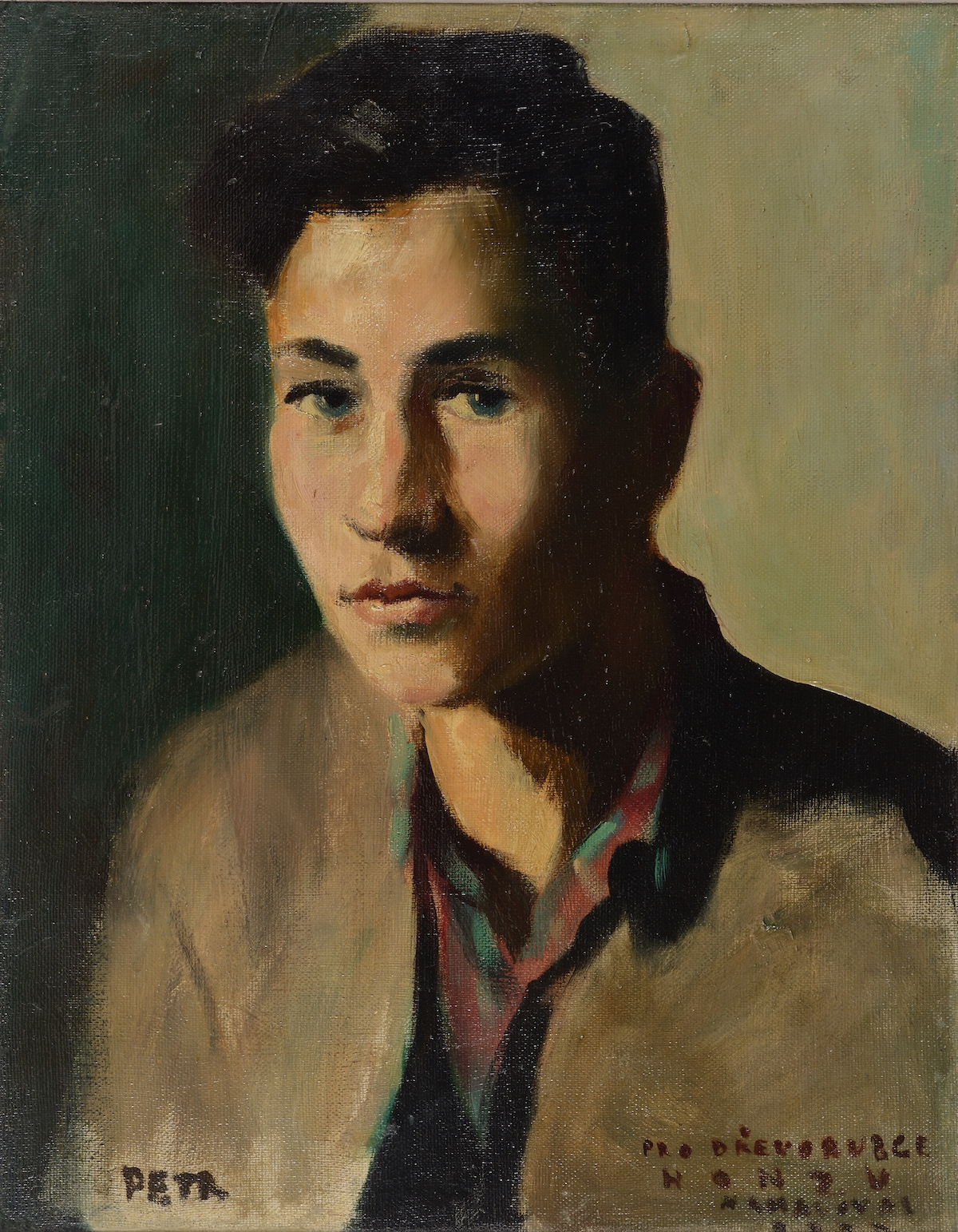
Peter Kien, Portrait of Jan Burka Age 16, Prague, 1940 (Oil on canvas, double sided-painting, 54 × 42 cm). Collection of the Yad Vashem Art Museum, Acquisition, courtesy of the bequest of Friedel Stern. Photo/Yad Vashem Art Museum, Jerusalem

Peter Kien, Portrait of Ilse Stránská - Kien (1915-1944), Prague, c. 1940 (Oil on canvas, double sided-painting, 54 × 42 cm). Collection of the Yad Vashem Art Museum, Acquisition, courtesy of the bequest of Friedel Stern. Photo/Yad Vashem Art Museum, Jerusalem
Boris Lurie
Survivors as Witnesses
Boris Lurie was born in 1924 to a Jewish family in Leningrad and grew up in Riga. He and his father survived several ghettos and concentration camps, including those in Stutthof and Buchenwald. His mother, grandmother, sister and childhood sweetheart were murdered in a mass shooting in the Rumbula forest near Riga in 1941. These experiences had a lasting effect on Boris Lurie’s life and art. In 1946, he immigrated to New York with his father. In 1959, together with a group of artist friends, he founded the NO!art movement, which opposed Abstract Expressionism and Pop Art, but above all the commercialization of art, and critically addressed issues such as racism, sexism and consumer culture.
Disseminating the Truth about the Crimes of the Holocaust
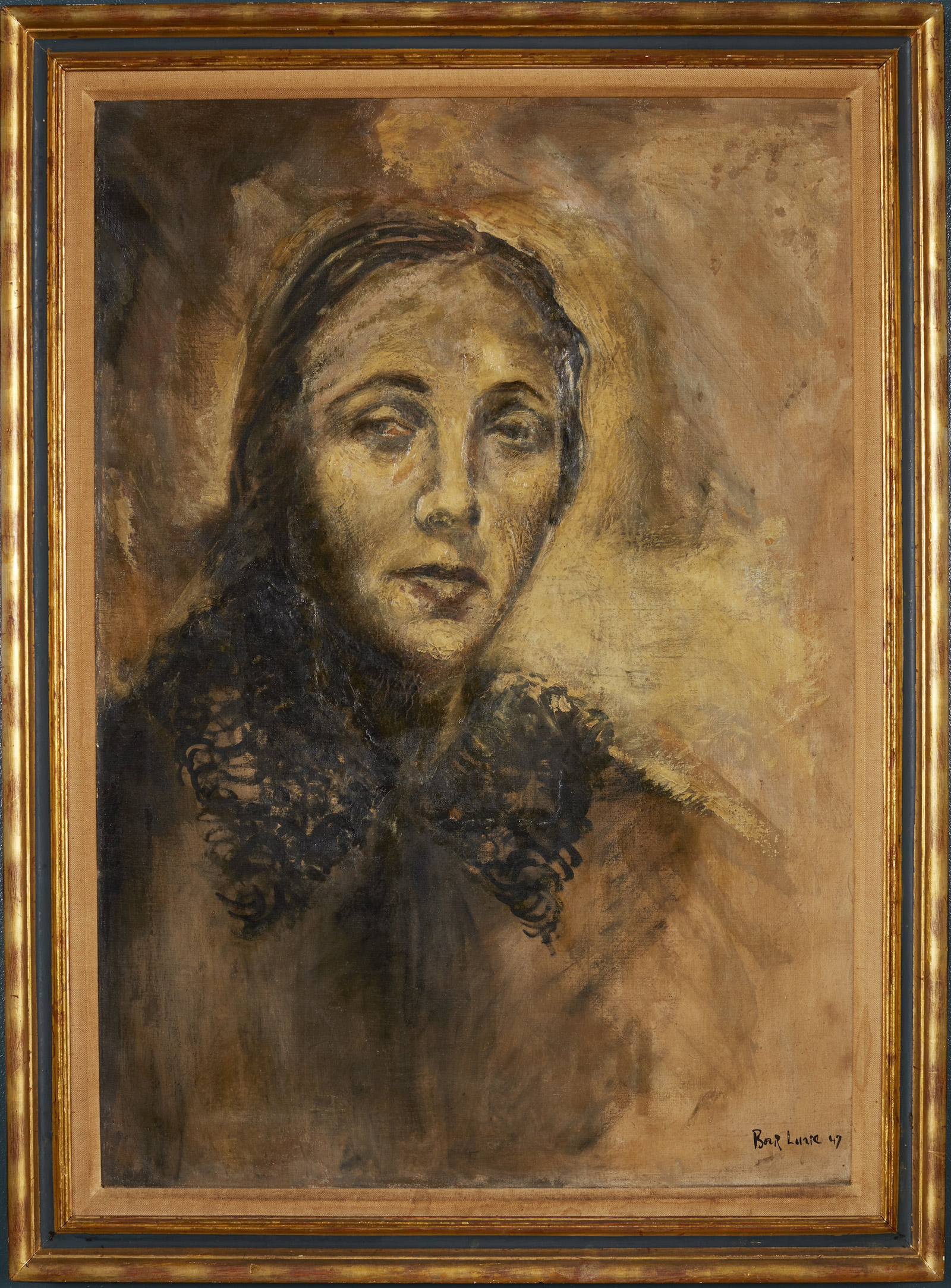
Boris Lurie, Portrait of My Mother Before Shooting, 1947 (Oil on canvas, 90 × 65 cm, reproduction). Boris Lurie Art Foundation

Boris Lurie, ca. 1946 (Ink paper 10 × 10.8 cm ). Boris Lurie Art Foundation

Boris Lurie, Prisoners Returning from Work, 1946 (Oil on Masonite, 50 × 70 cm). Boris Lurie Art Foundation
Jonasz Stern
Survivors as Witnesses
In the painting Talith over Kalusc by Jonasz Stern (1904–1988), the prayer shawl hovers over the landscape of the shtetl evoking a burial shroud, or a messenger of death from a painting by Marc Chagall. Of the approximately 7,000 Jews of Kalusc, only seventeen survived the Holocaust - Jonasz Stern was one of them. Stern escaped during a transport to the Bełżec death camp and returned to the Lwów ghetto, renamed the “Lemberg ghetto” by the occupying German forces, where he taught drawing to boys and girls.
On 1 June 1943, during the liquidation of the ghetto, he survived a mass shooting. He was not hit by the bullets and hid among the bodies of those who had been shot. He fled to Budapest and moved to Krakow in 1945. From 1954 to 1974, he was a professor at the Academy of Fine Arts in Krakow. He participated in the organization of the so-called “Second Krakow Group” and was its chairman for many years. He never forgot his experiences in the Holocaust and recorded them in impressive series of graphics.
Painting the Crimes of the Holocaust

Jonasz Stern, Kalusz in 1942 (Tallith over Kalusz), 1988 (Assemblage on canvas, 90 × 70 cm, reproduction). Collection of the Yad Vashem Art Museum, Jerusalem, Gift of Sonia Dombrowski, Düsseldorf. Photo/Yad Vashem Art Museum, Jerusalem
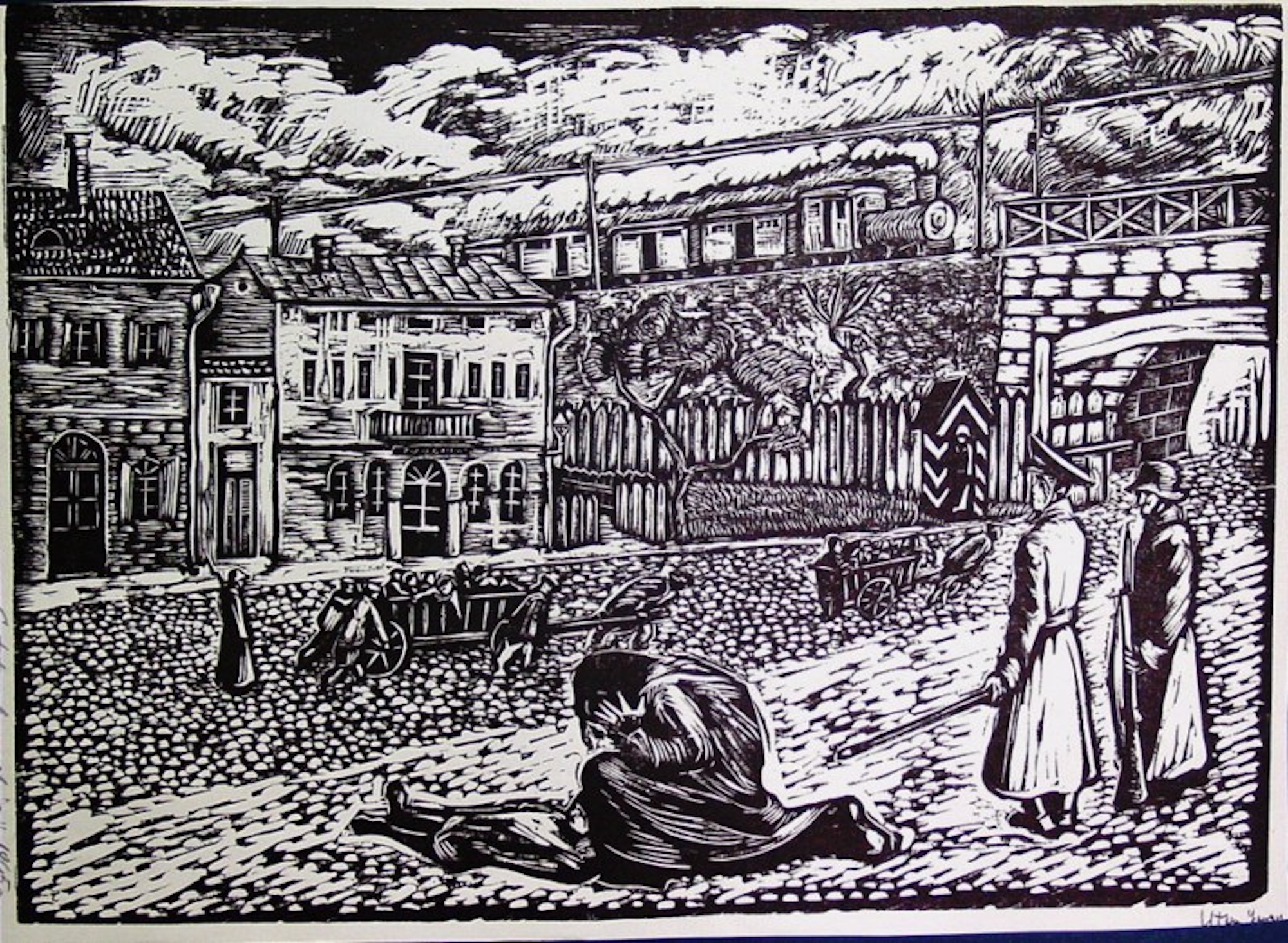
Jonasz Stern, Lemberg Ghetto, 1948, titled and dated in pencil, signed in pen (later) “Stern Jonasz” (Woodcuts, 23 × 31.6 cm). MOCAK Museum of Contemporary Art Krakow
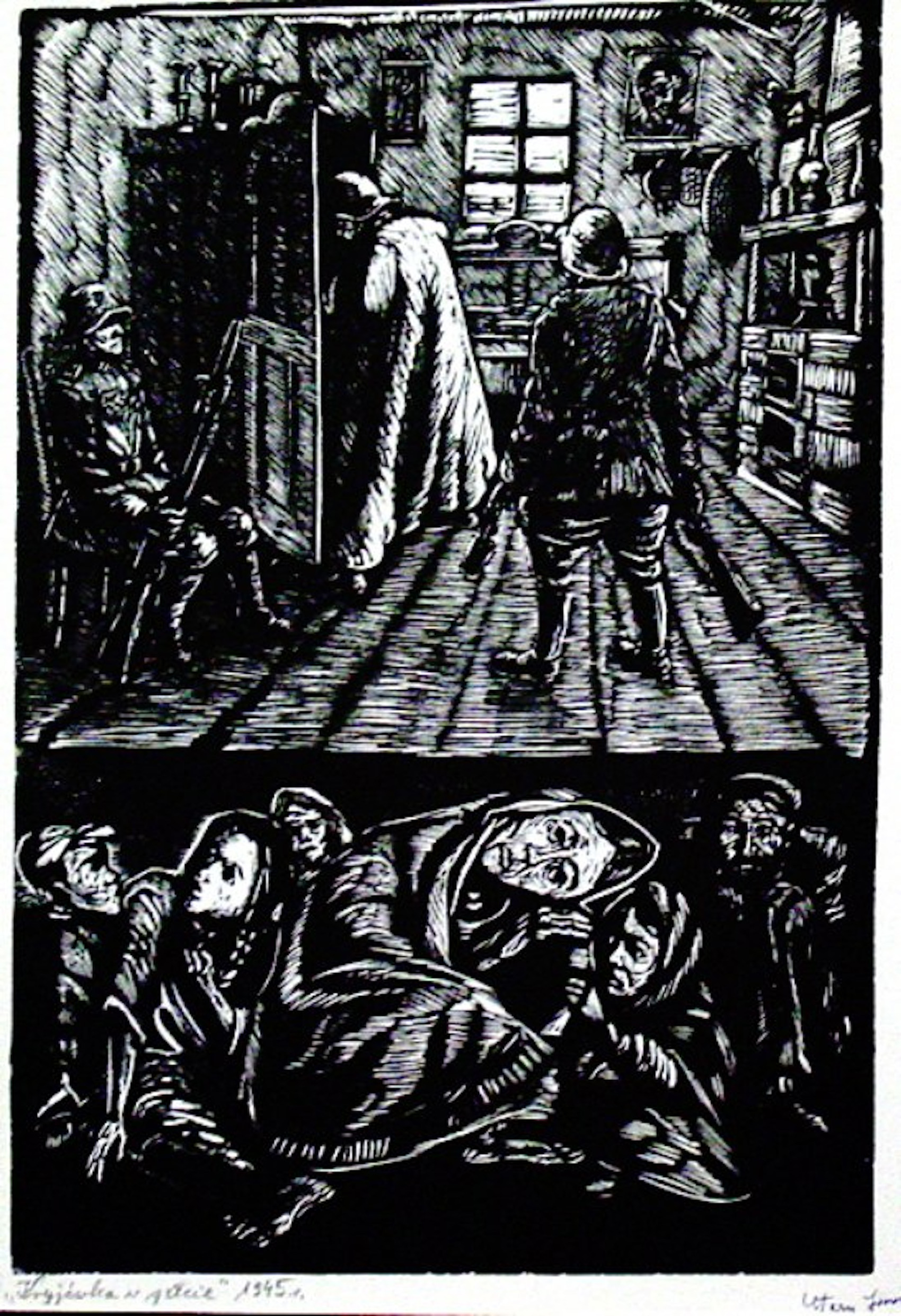
Jonasz Stern, Lemberg Ghetto, 1948, titled and dated in pencil, signed in pen (later) “Stern Jonasz” (Woodcuts, 23 × 31.6 cm). Museum Center for Persecuted Arts
Yehuda Bacon
Dialogue Through Art
Yehuda Bacon was born in 1929 in Moravská Ostrava, Czechoslovakia. In 1942, he and his family were deported to the Terezín ghetto. The adult prisoners organized cultural programs for the children, and Yehuda Bacon was given drawing lessons with other boys and girls. In 1943, he was deported to the “Family Camp” at Auschwitz Birkenau German Nazi Concentration and Death Camp (1940-1945). In 1944, Bacon was transferred to the men’s camp, and assigned to a group that transported goods to different parts of the camp. As one of the few survivors of the death march to Mauthausen, he was liberated at the Gunskirchen camp. In 1946, he immigrated to Mandate Palestine, where he studied at the Bezalel Academy of Art and Design in Jerusalem. Bacon’s experiences during the Holocaust deeply influenced his art, which expresses not only the suffering of the past, but also his return to life.
Immediately after his liberation, he made small sketches of the crematoria and gas chambers of Auschwitz Birkenau German Nazi Concentration and Death Camp (1940-1945), which were later used as evidence at the Eichmann trial of 1961, in which he personally testified. He was also a witness at the Frankfurt Auschwitz Trial, which took place from 1963- 1965. Bacon remained a dedicated educator well into his old age, working to ensure that the memory of the Holocaust would be ingrained in the minds of future generations. His interactions with students, educators and the public have left an indelible mark on Holocaust education. One of his most famous students is the contemporary artist, Sigalit Landau.

16-year-old Yehuda Bacon in Prague in April 1946. Civic Foundation for Persecuted Arts
Witness Testimonies
Yehuda Bacon demonstrated his commitment to justice and the power of eyewitness testimony at the Eichmann Trial in Jerusalem (1961) and Auschwitz Trial in Frankfurt am Main (1964).
“What does it mean, hope? I knew exactly that like everyone, of course I will die in the end. But still I asked the people from the crematorium, ‘Please tell me your story, please explain to me what that is.‘ And they said, ‘What do you need to know it, nobody will survive here, that’s clear.‘ And I knew that they can burn my body, but in each of us is a part which existed before we were born and will never die.” – Gallery talk between Yehuda Bacon and Eliad Moreh-Rosenberg, Yad Vashem Art Museum, 11 July 2016
“I was for a long time a teacher, so what does it mean to be a teacher? You give only the text? Or you give a part of yourself? And that‘s the most difficult thing, to educate. When we are young we have to take, but then, we have to give. It‘s like a pipe, you take and you give. And the artist is the one who can deeply go to the roots, to the common roots, and bring them up to the tree of life. I think everyone has a personal duty, [and should ask oneself] what can I do with this life?” – Gallery talk between Yehuda Bacon and Eliad Moreh-Rosenberg, Yad Vashem Art Museum, 11 July 2016
“I had to be a witness. I had to speak for the children who didn‘t survive. I had to do my duty, my responsibility.” – Yehuda Bacon
Drawing of the young Yehuda Bacon
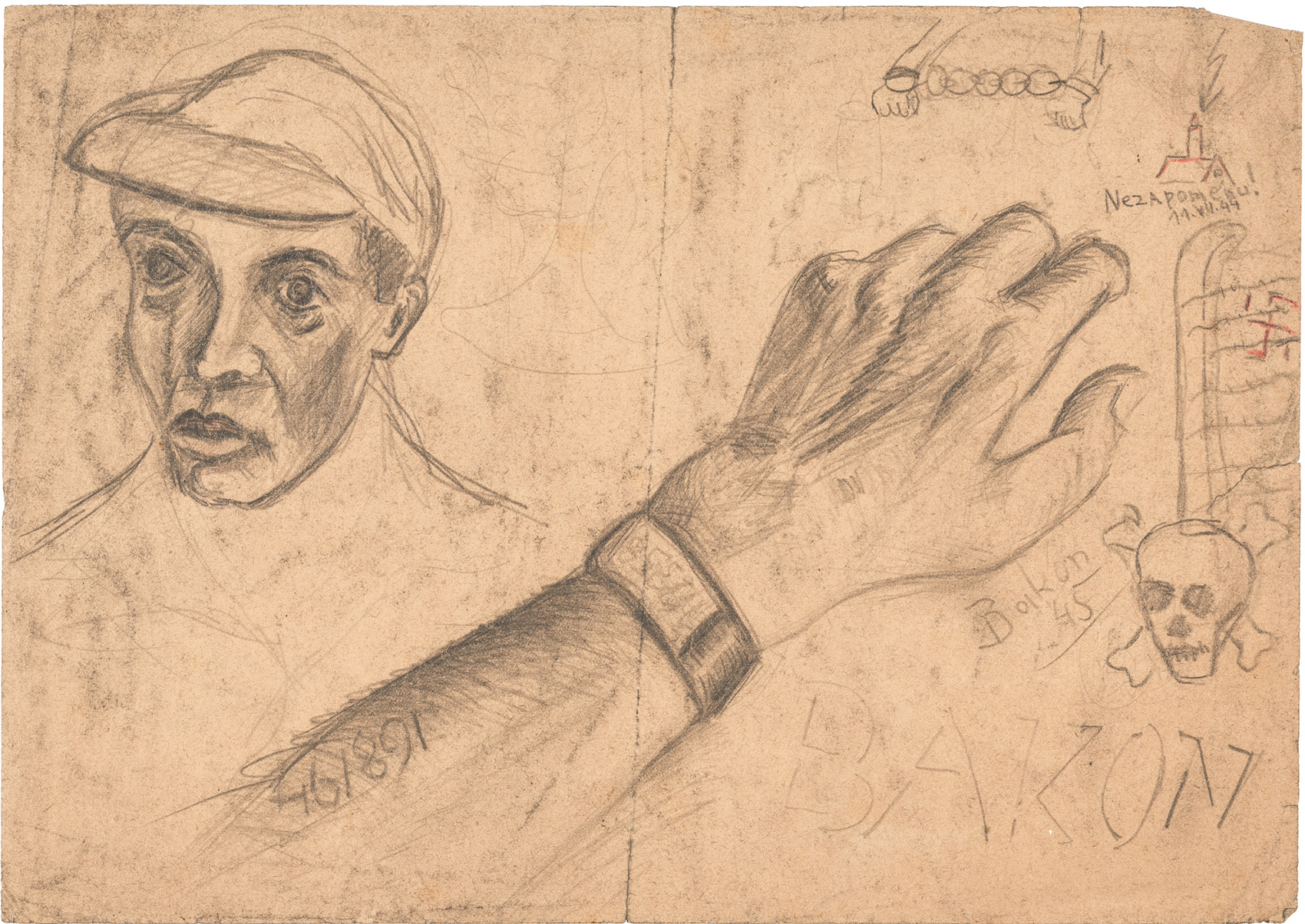
Yehuda Bacon, 1945 On the arm projecting into the picture, Bacon inscribed his own prisoner number: 168194 (Drawing, 20.8 × 29.7 cm). Museum am Dom, Diocese of Würzburg, Art Collection Foundation

Yehuda Bacon, Before the Transport to Terezín, 1945 (Watercolor and ink on paper, 21.8 × 29.7 cm, reproduction). Collection of the Yad Vashem Art Museum, Jerusalem. Photo/Yad Vashem Art Museum, Jerusalem
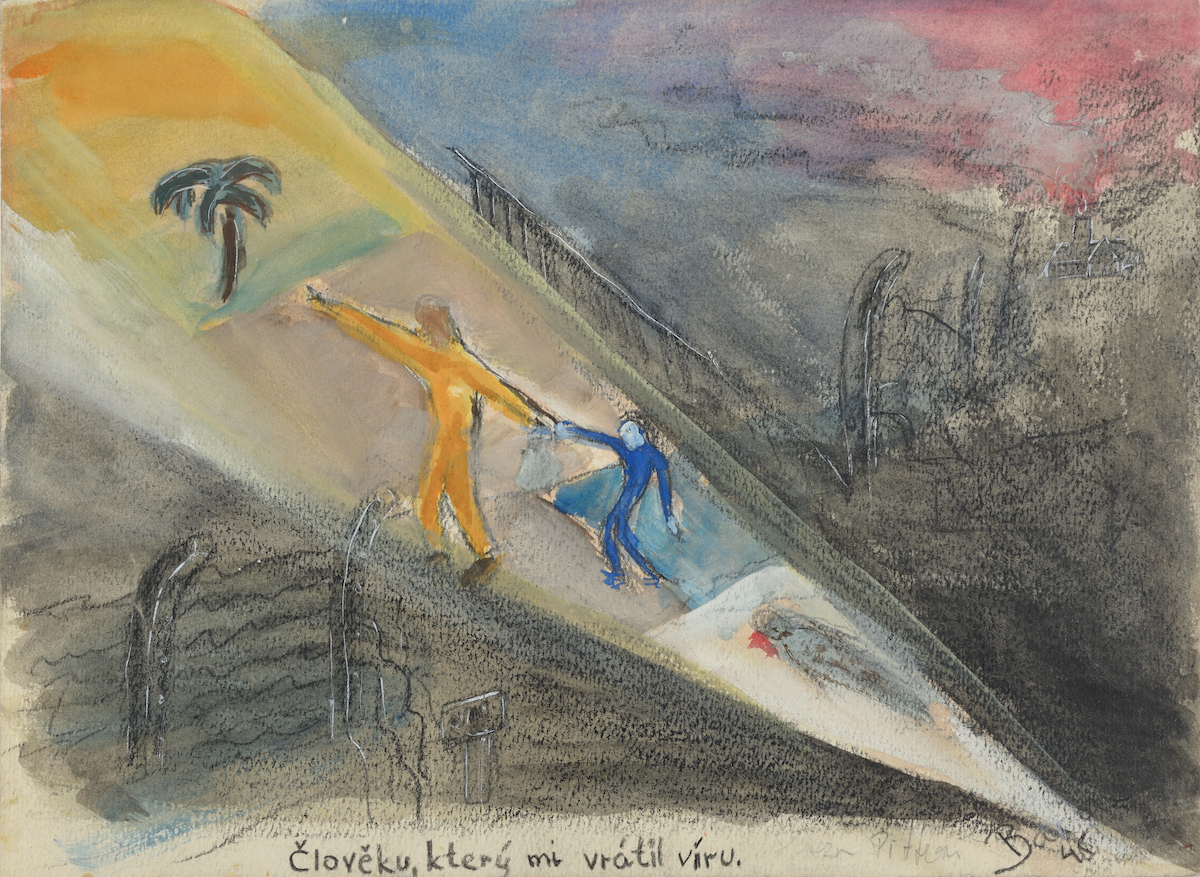
Yehuda Bacon, To the Man who Restored my Belief in Humanity, 1945 (Gouache, black chalk and pencil on paper, 22.1 × 30 cm, reproduction). Collection of the Yad Vashem Art Museum, Jerusalem. Photo/Yad Vashem Art Museum, Jerusalem
This work is dedicated to the Czech educator Pitter Přemysl, who worked to save Jewish and non-Jewish children during and after the Holocaust and was recognized as a Righteous Among the Nations in 1964.

Yehuda Bacon (Aquarell, 10 × 20 cm, reproduction). Museum am Dom Würzburg, Diocese of Würzburg, Art Collection Foundation. Photo/Art Collection Foundation
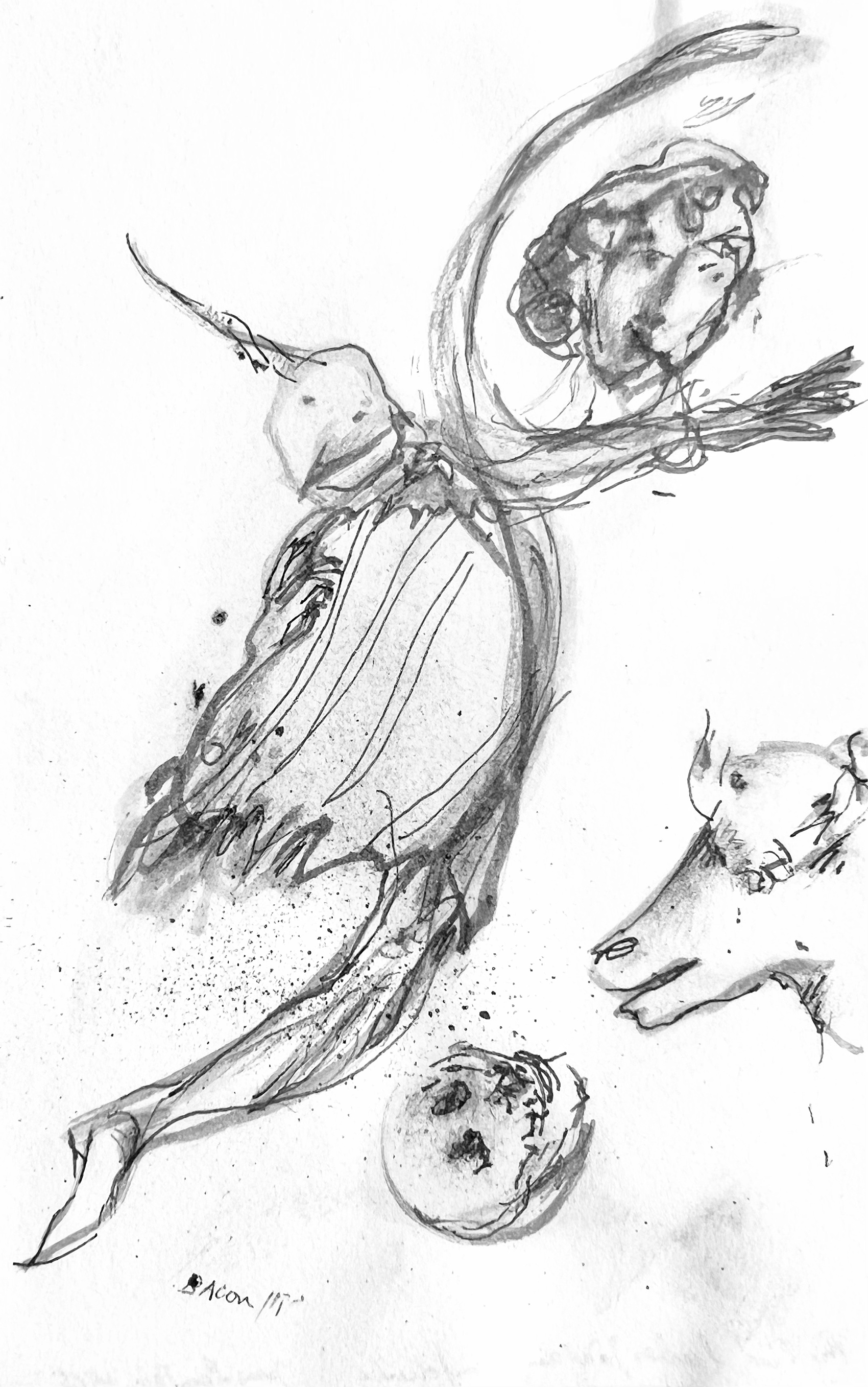
Yehuda Bacon, Drawing (Ink and watercolor on paper, 15 × 9 cm). Private collection

Yehuda Bacon, Woman with child at the barbed wire fence of a concentration camp (signed Yehuda Bacon) (Drawing, 21.8 × 16.2 cm, reproduction). Museum am Dom Würzburg, Diocese of Würzburg, Art Collection Foundation. Photo/Art Collection Foundation
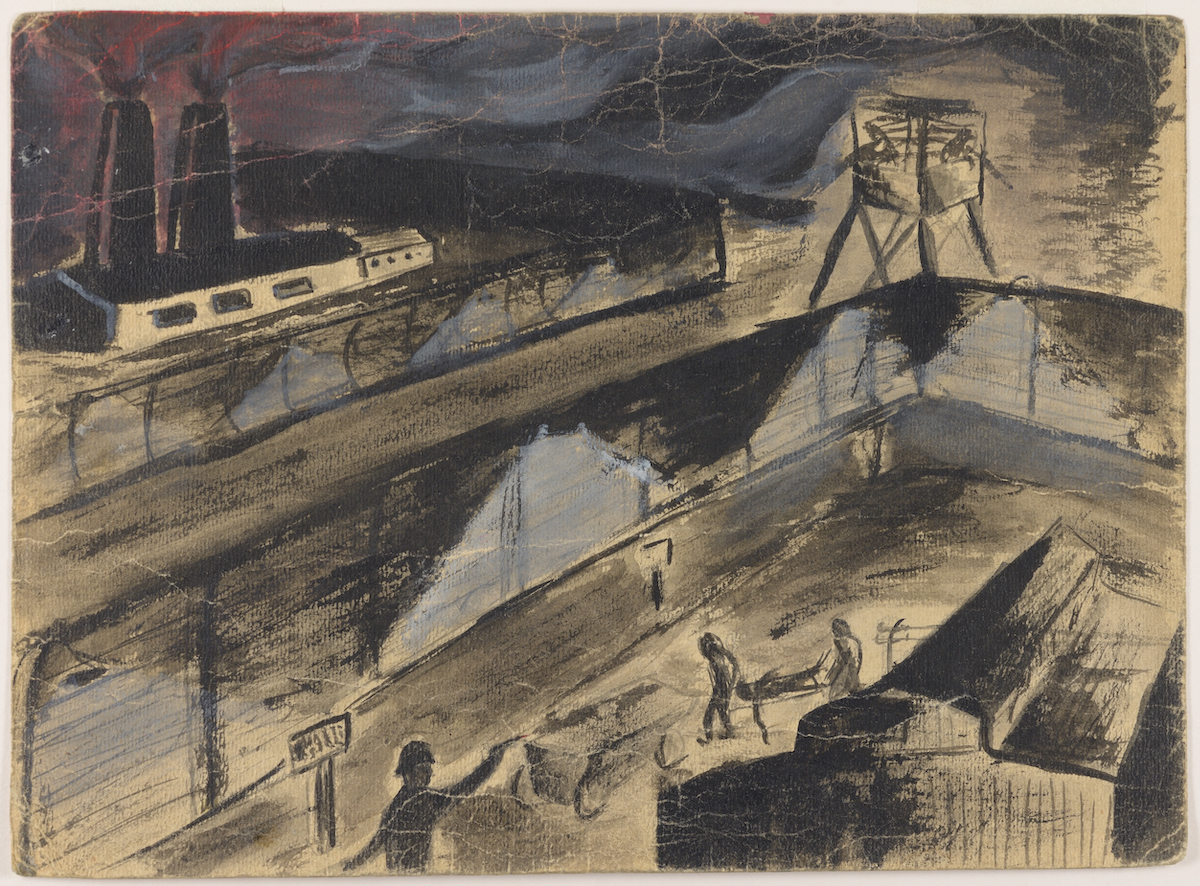


Yehuda Bacon, Recollections from Auschwitz In Remembrance of the 20.5.44 Transport, Crematorium No.3 & 4, The Transport Arrives, 1945 (Charcoal on paper, 23 × 31 cm, reproduction). Collection of the Yad Vashem Art Museum, Acquisition, courtesy of the bequest of Friedel Stern. Photo/Yad Vashem Art Museum, Jerusalem
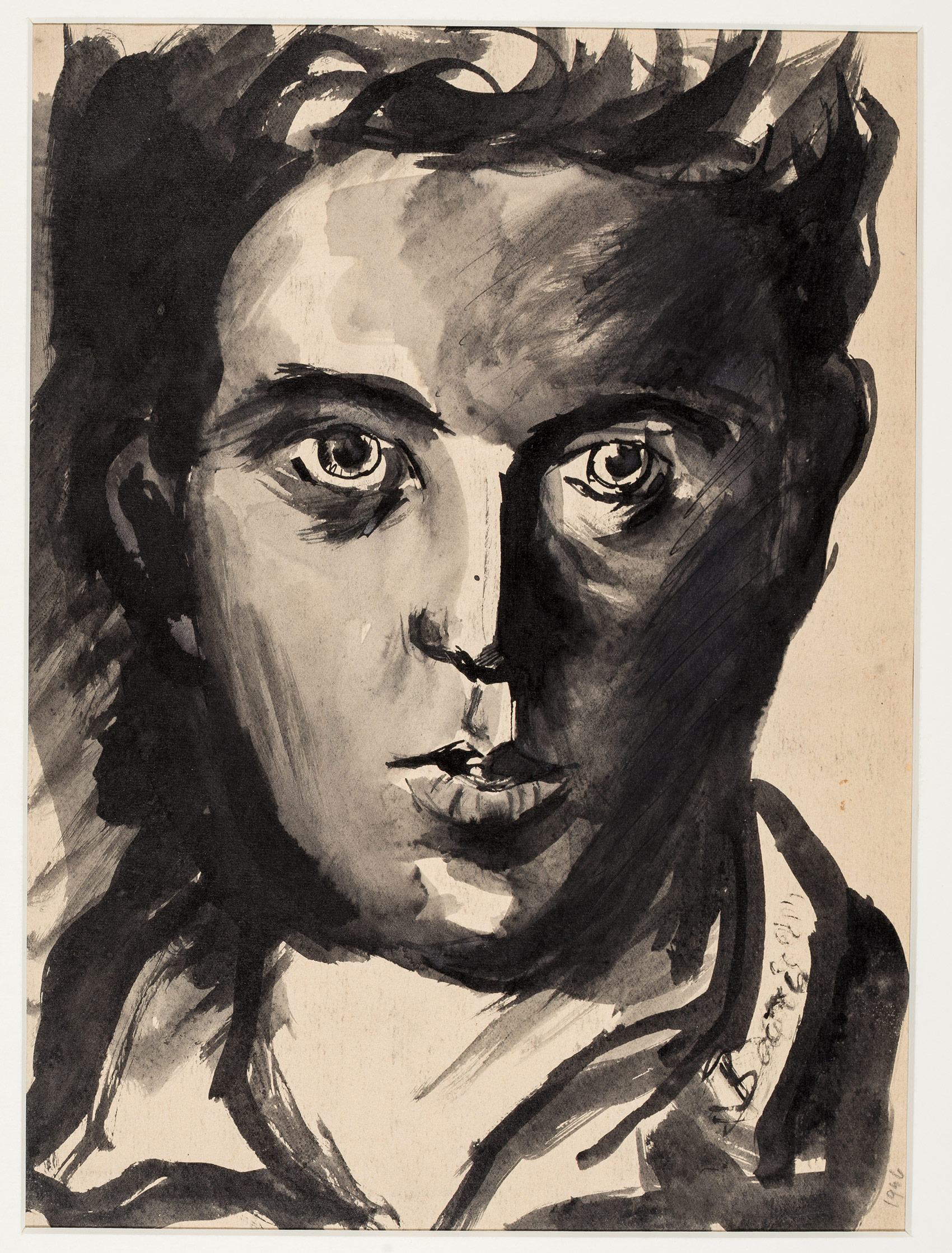
Yehuda Bacon, Self-portrait, 1946 (Brush in ink on paper, 28.2 × 21 cm, reproduction). Museum am Dom Würzburg, Diocese of Würzburg, Art Collection Foundation. Photo/Art Collection Foundation

Yehuda Bacon, Self-portrait with prisoner‘s number, 1946/47 (Brush in ink on paper, 59.8 × 41.3 cm, reproduction). Museum am Dom Würzburg, Diocese of Würzburg, Art Collection Foundation. Photo/Art Collection Foundation

Yehuda Bacon, 1946 (Drawing, 29.8 × 22.1 cm, reproduction). Museum am Dom Würzburg, Diocese of Würzburg, Art Collection Foundation. Photo/Art Collection Foundation
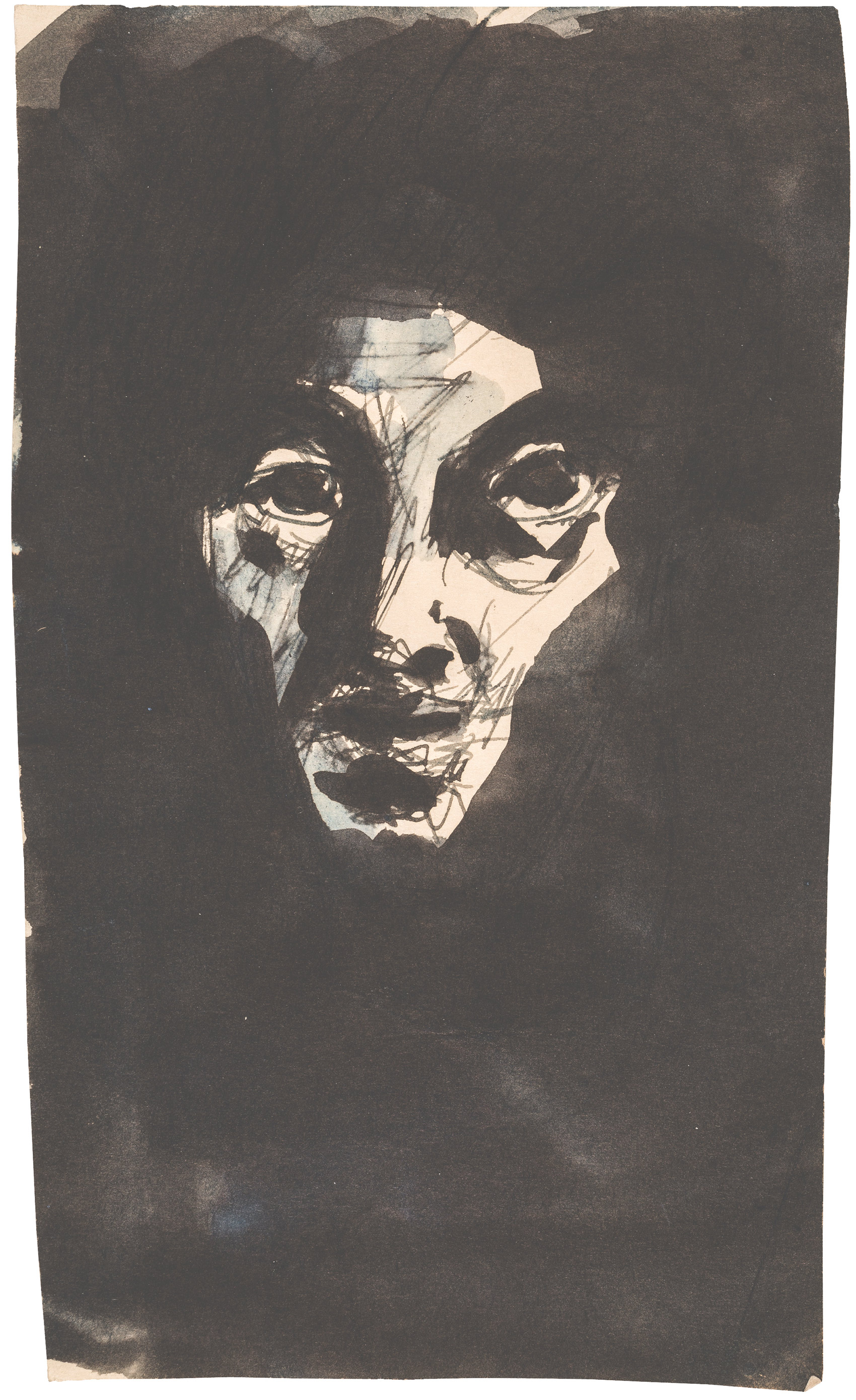
Yehuda Bacon, (Drawing, 16.3 × 9.7 cm, reproduction). Museum am Dom Würzburg, Diocese of Würzburg, Art Collection Foundation. Photo/Art Collection Foundation
On the second anniversary of his father’s death in Auschwitz Birkenau German Nazi Concentration and Death Camp (1940-1945), the artist drew a portrait of his father Israel Bacon rising from a smoking chimney. On the right, Bacon noted the exact date and time when his father was murdered, along with some 7,000 other Czech Jews: “22:00 10.VII.44”.

Yehuda Bacon, In Memory of the Czech Transport to the Gas Chambers, 1945–1946 (Charcoal on paper, 41 × 32.5 cm, reproduction). Photo/Yad Vashem Art Museum, Jerusalem
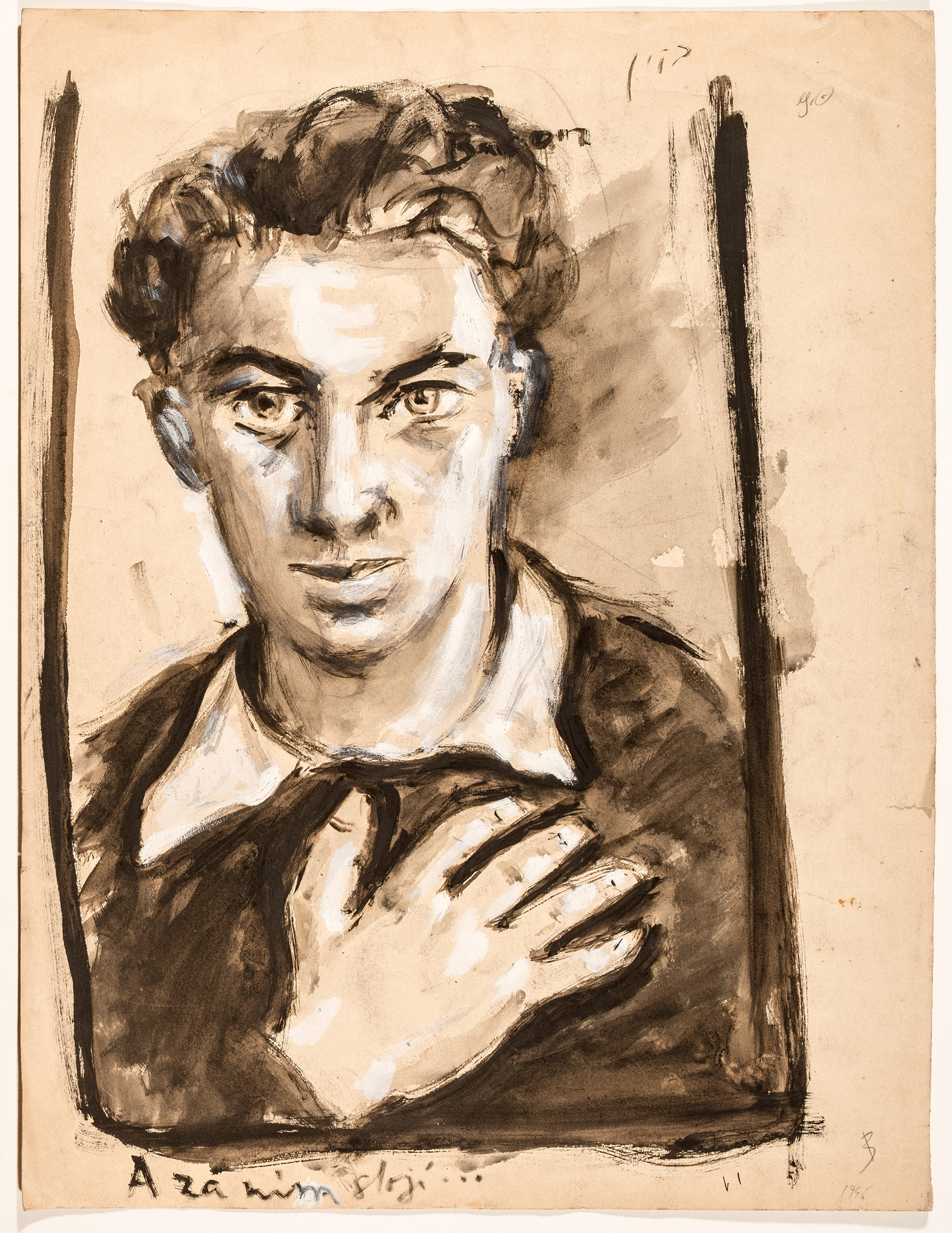
Yehuda Bacon, Self-portrait, 1946 (Brush in ink, opaque white on paper, 51 × 38,6 cm, reproduction). Museum am Dom Würzburg, Diocese of Würzburg, Art Collection Foundation. Photo/Art Collection Foundation

Yehuda Bacon, Self-portrait, 1948 (Gouache on paper, 41 × 32 cm, reproduction). Museum am Dom Würzburg, Diocese of Würzburg, Art Collection Foundation. Photo/Art Collection Foundation
“And the artist is the one who can deeply go to the roots, to the common roots, and bring them up to the tree of life.” - Yehuda Bacon
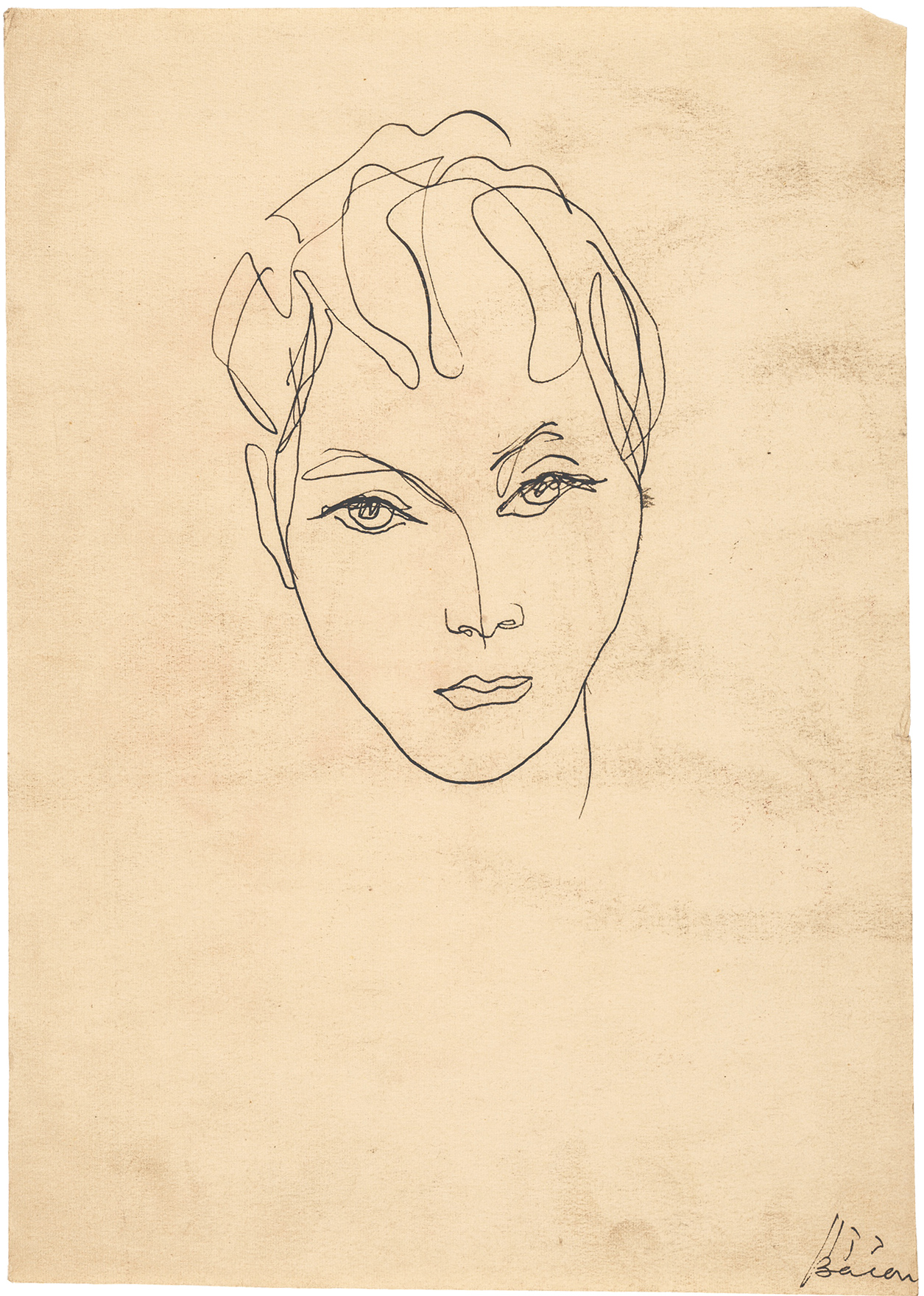
Yehuda Bacon, Portrait drawing (signed Yehuda Bacon) (Drawing, 26.8 × 18.8 cm, reproduction). Museum am Dom Würzburg, Diocese of Würzburg, Art Collection Foundation. Photo/Art Collection Foundation
Karel Fleischmann
Teacher of Yehuda Bacon in Terezín

Karel Fleischmann The Food Queue, Terezín Ghetto, 1942 (Watercolor, India ink and wash on paper, 9 × 10.7 cm, reproduction). Collection of the Yad Vashem Art Museum, Jerusalem, Gift of the Prague Committee for Documentation, Prague, courtesy of Ze‘ev and Alisa Shek, Caesarea. Photo/Yad Vashem Art Museum, Jerusalem
Sigalit Landau
Generational Impact
Sigalit Landau was born in Jerusalem in 1969 and grew up near the Hebrew University on Mount Scopus. Her father is a survivor of the Nazi labour camp in Bukovina. Her maternal grandparents were Austrian Jewish refugees who immigrated to England and were interned there as enemy aliens. Yehuda Bacon was Sigalit Landau’s first drawing teacher, and she recalls him with much gratitude and affection. Today, she is an influential artist and her work is shown in major museums and venues worldwide. For an exhibition in the German Bundestag in 2015 she created a work of art that, on the one hand, was intended to recall the presentation of the shoes of the murdered that can be seen in the exhibition at the Auschwitz Birkenau German Nazi Concentration and Death Camp (1940–1945). On the other hand, the work symbolizes the re-emergence of families from the few survivors of the Holocaust. The installation is entitled, Victory of Memory – Island of Shoes.
An almond tree in full bloom fills the screen. Suddenly the treetop is shaken harshly, the branches arch and bow while petals fall from the flowers, filling the frame and floating through the air to the ground. The branches’ monotonous rocking implements a simple cinematic effect. That which has been shaken, damaged and violated is being repaired. The seamless beauty of art seemingly undoes violence.
The Victory of Memory
“As infants we walk bare feet, free from protection and interruption. But soon this comes to an end. For most of the rest of our lives we walk with our feet wrapped and protected. We recognize the concept of piling of objects and clothing, and especially as Jews it is always a difficult concept to grasp and digest. Piles of shoes, mountains of shoes, picked and ripped out, shoes of grandchildren, grandparents, rabbis, and shoes of hard working people, standing inside them, restless...” – Sigalit Landau
Sigalit Landau collects hundreds of pairs of shoes and puts them in a pile, as an island, inside the sea of salt. The sea wraps them in countless layers, protects them from another disaster, a perpetual process. Shoes that lived and died, and maybe now will get a new meaning, one with an eternal dimension. Sigalit Landau‘s mountain evokes a memorial, an island of remembrance in a sea of death. It beckons the viewer closer for reflection and meditation. Sigalit Landau created this artwork for the opening exhibition of the Museum Center for Persecuted Arts. It was first shown in the German Bundestag in Berlin in 2015.

Sigalit Landau, Photo of the installation Victory of Memory – Island of Shoes, 2015, (Shoes, Salt, 300 × 300 cm, reproduction). MOCAK Museum of Contemporary Art in Krakow
Father and Tufik - Frederick (Simha) Landau, b.1940, Vatra Dornei, Bukovina, Romania
“When Freddy was about three years old, my grandparents discovered to their horror that their son was filching food from their meager store of supplies to feed a dog named Tufik. Freddy’s parents could barely feed Freddy and his older brother, the late Yisrael Landau. I am sure they were furious, and obviously Tufik‘s feeding was summarily stopped. My father used to tell and retell the story of “his” special dog, and would mention this episode throughout my entire childhood. He would imitate his call to the dog, "Tufik, Tufik, nah! Nah!"

Sigalit Landau, Father and Tufik, 2014 (Bronze cast, 22 × 25 × 14 cm, reproduction). Collection of the Yad Vashem Art. Museum, Jerusalem, Gift of the artist. Photo/Yad Vashem Art Museum, Jerusalem
This exhibit was launched in November 2023
